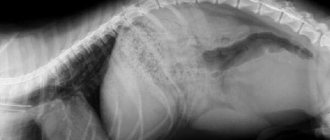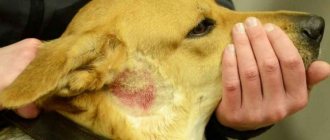Physiological abnormalities
The Pomeranian rarely gets sick and is able to remain active and cheerful into old age.
This health problem may arise due to: the breed's characteristic small size; anatomical warehouse; genetic abnormalities; improper care.
Typical problems:
Take the Attention Test! Find 10 differences! (click right here!)
Find the answer Are you bothered by some problem or question? Enter “Breed” or “Name of the problem” into the form, press Enter and you will find out everything about the issue that interests you.
- Weak musculoskeletal system;
- Dental pathology;
- Eye diseases;
- The peculiar structure of the larynx;
- Genetic diseases.
The breed is distinguished by a weak skeletal system. Joints are susceptible to dislocation and deformation. Fragile bones and ligaments sometimes cannot withstand movement. If a Spitz is obese, then problems with the musculoskeletal system cannot be avoided. Excess weight puts extra strain on your dog when he runs or jumps.
This joint problem will be expressed through movement. The dog may limp, jump when running, or move its front paws incorrectly. The pet will begin to get tired quickly and refuse to run.
You can reduce the risk of these problems with a balanced diet. The Spitz needs vitamins and minerals to strengthen bones and muscles. If the puppy is not strong enough, do not allow him to jump high or walk up the stairs. Monitor your pet's weight.
Dwarfism of the breed appears as a pathological manifestation of miniatureness. Mini Spitz dogs have impaired pituitary gland function. These are weak creatures with bulging eyes, an unformed fontanelle, and a problematic nervous system.
Dental disease often occurs due to the structure of the jaw. It may be difficult to change teeth. Sometimes baby teeth do not fall out on their own. This is the first cause of abnormal growth of molars. Owners often have to remove their pet's baby teeth at veterinary clinics.
Oranges often develop tartar and periodontal disease. This may be due to the shape of the jaw and improper care.
Spitz eyes are prone to severe tearing. Due to the short muzzle, the eyeball protrudes greatly. The animal's eyes are vulnerable to external irritants. Your pet's eyes should be examined regularly and wiped with special solutions.
The larynx of Pomeranians has a special structure. Unclosed cartilage plates cause coughing. Against the background of an infection, the trachea softens and collapses. Coughing attacks occur during rapid breathing and when the animal is restless.
Congenital diseases include:
- Hip dysplasia;
- Retinal atrophy;
- Disease of the thyroid gland and adrenal glands;
- Epilepsy.
Congenital pathologies cannot be prevented; their symptoms can be alleviated.
Other difficulties encountered
Dogs often suffer due to owner irresponsibility.
An animal without timely vaccination can contract enteritis, distemper, and viral hepatitis.
Neglect of preventive measures leads to infection with parasites and related diseases.
A number of problems are caused by poor nutrition. Poor quality food can cause diarrhea or constipation. Possible food allergies, which will affect the condition of the skin. The dog develops skin itching and dandruff. You cannot overfeed your pet and spoil it with food from the table. The quality of feed affects the functioning of the liver, kidneys, and gastrointestinal tract.
Don't turn your Spitz into a lap dog. He benefits from moderate physical activity. Otherwise, your pet will have weak muscles and fragile joints. Infrequent exposure to fresh air reduces immunity. A sedentary dog is susceptible to gaining excess weight.
Follow hygiene procedures. Take care of your pet's mouth, eyes, ears, and fur.
When signs of illness appear, it is important to start treatment on time.
Treatment of skin diseases in dogs
Of course, depending on the type of skin pathology, treatment will be selected individually. The direction of action of the drugs is determined by the course of the disease. However, for all skin dermatitis there is a standard regimen (excluding immune pathologies): an antibacterial agent, an antibiotic (in case of complications and the spread of infection throughout the body), regulating the functioning of the immune system, restoring.
Tests and diagnostics
First of all, at the very beginning of treatment, the pet needs to undergo a series of tests that will help determine the nature of the disease and the stage of its development. To do this, blood, urine, feces, samples of keratinized skin, smears from the vagina and other parts of the body can be taken from the animal. Ultraviolet radiation is often used to determine fungal disease.
Prevention
Basic measures to prevent and prevent recurrence of the disease:
- Proper diet, drinking regimen;
- Clean dishes and personal items (combs, bed, toys);
- No contact with stray animals;
- Timely vaccination and treatment against external parasites;
- Complete treatment of all bacterial and infectious diseases;
- Periodic examinations by a veterinarian;
- Frequent home skin examinations;
- Maintain good hygiene (bathing, brushing).
- Restoring and maintaining immunity.
Skin diseases may seem harmless. If you start treatment on time and complete a full course of getting rid of the pathology, then these diseases do not pose a danger to your pet. Otherwise, when the process is started, deaths may occur.
Diseases and signs that definitely show that not everything is okay
When a dog is sick, he is ready to convey this to his owner in different ways, except that he cannot speak, so you should be attentive and listen to the signals sent by your pet. it's time to sound the alarm.
There are many diseases, each with different consequences. It is important to identify it and reduce the harm. The disease can be identified by the first symptoms that appear.
There is no need to set yourself up for negative thoughts if suddenly the dog seems lethargic to you. Think about it, even you have this condition from time to time. If you know that your dog loves to chew everything he finds on the street, then be prepared for frequent stomach upsets, which you don’t need to worry about.
If something worries you, it is better to double-check your pet’s health status. Symptoms will be varied, even unpredictable.
There are 3 main ones that you should pay attention to first:
- Fever;
- Apathy, lethargy;
- Refusal of food.
Every veterinarian should learn about dog diseases, their signs and treatment. Symptoms will become harbingers of both the mildest and fatal diseases. There is no need to draw any hasty conclusions and, especially, treat your pet yourself. Only a veterinarian can establish an accurate diagnosis and prescribe the correct effective treatment.
Spitz diseases: overview of ailments, their causes and symptoms
The Pomeranian Spitz is a dog characterized by good health. This is evidenced by their average life expectancy, which is 14 years. However, like any other breed of dog, these dogs are prone to various types of diseases. We will look at Spitz diseases (review of the main ailments, symptoms, therapy) in our article.
Spitz diseases
Common Pomeranian Diseases
- Hypoglycemia.
It refers not so much to a disease as to a physiological condition. Formed in puppies with low weight. The metabolism is changed, therefore, by reducing the glucose level, it is necessary to provide the pet with frequent meals to prevent the occurrence of convulsions. Causes of hypoglycemia in dogs, symptoms, treatment - Bad breath is also a common problem. The reason for the appearance of an unpleasant odor is considered to be tartar or a functional disorder of the gastrointestinal tract.
- Problems with the eyes include the following pathologies: increased tearfulness, clouding, abnormal position of the eyelid, in which the conjunctiva and cornea are injured by its ciliated edge, pathological processes with dystrophic degeneration of the retina.
- Congenital displacement of the kneecap. This disease can progress due to any injury received.
- A disease of black skin, which is characterized by baldness and partial loss of hair.
Black skin disease in Spitz dogs - Coughing and tracheal collapse. Coughing worsens during play or when the dog is overly excited. The special structure of the larynx is considered to be a factor in the appearance of cough. Therefore, it is necessary to monitor the dog’s health, since coughing with wheezing is a chronic illness and is characterized by an inherited deformation of the organ, leading to its narrowing.
Diseases of the gastrointestinal tract
The Spitz is a dog that is unpretentious to food. Therefore, you can include meat products and a variety of cereals with vegetables in the menu. The main threat is an incorrectly formed menu, which can become a factor in the development of gastrointestinal diseases in Pomeranians, including problems with food digestion.
Gastrointestinal morbidity statistics
Ulcer
Peptic ulcer disease appears when, when gastritis occurred, the owner did not consult a doctor and the pet was not prescribed proper treatment.
Over time, inflammation worsens the dog’s health and as a result, an ulcer forms on the walls of the stomach. To avoid the death of your dog, you need to contact a veterinarian in time.
Peptic ulcer disease also has certain symptoms:
- loss of appetite;
- liquid stool streaked with blood;
- The dog vomits (vomits blood, bile comes out).
Taking into account the stages of development of the disease, the veterinarian will prescribe special treatment or recommend surgery.
Food poisoning
Pomeranian food poisoning can be caused by low-quality or expired food. Signs of an intestinal infection include:
- the appearance of vomiting;
- temperature increase;
- the dog is constantly in a lying position;
- Drinks only water, without touching food.
Is your dog constantly lying down? She might be poisoned
Therapy consists of taking activated charcoal (about four tablets, the exact dose should be checked with your veterinarian), as well as drinking plenty of liquid.
What diseases cause skin to peel?
When your pet's skin peels, this is a sign of dermatosis.
Table. Diseases that can cause peeling skin in dogs .
Disease Image Description
| Pyoderma | A pustular skin disease, which is characterized by itching, the appearance of scales of dead epidermis on the skin surface, and the appearance of red and yellow blisters. If the bubbles are opened, an unpleasant odor will appear. In case of illness, the doctor will prescribe complex treatment against pathogenic bacteria, improving immunity |
| Atopy | An allergic response of the dermatological surface, which is mainly expressed seasonally. Medical indicators include: irritation, peeling, sneezing, baldness, red eyes |
| Allergic reaction to food | This type of allergy is characterized by severe itching, redness of specific areas of the skin, rashes, discharge from the eyes and nasal cavity, and swelling of the larynx. Therapy involves eliminating the allergen from the menu, sometimes treatment is symptomatic |
| Inflammatory skin lesions due to flea bites | This is an allergic dermatitis with the following symptoms: severe itching, hair loss, loss of interest in food, vomiting, and the appearance of scales on the skin. For treatment to be effective, you need to get rid of the parasite attack |
| Scabies | This is a tick infestation. Medical symptoms of scabies include severe irritation, the appearance of spots on the surface of the skin, scales, loss of appetite, and sometimes fever. Itching is treatable, but with timely treatment |
| Pemphigus | The disease is the appearance of ulcers and scabs on the skin with fluid-filled blisters. The dog is prescribed steroid substances, put on a diet and eliminated from consuming high-fat foods |
| Hypothyroidism | The disease is characterized by a lack of hormone production by the thyroid gland. The dog may become bald; the wounds will take a long time to heal. Therapy involves the use of hormonal substances, dietary nutrition |
| Demodicosis | The disease appears when infected by subcutaneous mites. Symptoms of the disease: the appearance of redness, baldness, low temperature, the appearance of scales. Medical measures are aimed at eliminating pyoderma, improving immunity, and removing toxic substances |
| Seborrhea | A skin disease, the hallmarks of which are increased oiliness of the skin and dandruff. In this case, you can only control the dog’s position, since the disease cannot actually be cured. Symptomatic treatment involves the use of special shampoos |
| Dermatosis due to zinc deficiency | The disease is explained by zinc deficiency. When the disease is at the formative stage, the dog’s skin peels, redness occurs, and alopecia is visible. When the lack of vitamin is persistent, the dog’s injuries and wounds heal slowly, and the dog’s weight rapidly decreases. The best preventative measure for the disease is the introduction to the menu of products with a large amount of vitamin |
There can be a large number of reasons why a dog’s skin on its back is peeling. Based on the information described above, any owner should understand that they will not be able to cope with the issue of peeling on their own.
If you notice this sign, try to immediately show your pet to a specialist. The main actions of the doctor in such cases are focused on the treatment of pyoderma, which often accompanies skin diseases. Treatment includes taking medications, some antibacterial substances and ointments for skin diseases.
The results of treatment are noticeable after 30 days of intensive therapy.
Fontana problems in Pomeranians
Everyone knows that the fontanel is located on the top of the head. It is also present in newborn puppies. Why do Pomeranians have fontanelle problems? For example, in large dogs they close up a couple of months after birth, but in miniature breeds the “hole” often remains for a long time.
If you are not sure whether your pet’s fontanelle has healed, contact a specialist.
The fontanel itself does not pose any danger. Between the brain and the skin there is quite strong connective tissue that protects the important organ. The fact is that difficulties with the fontanelle appear only in dogs that are bred for exhibitions.
How to find a fontanel? You need to place your finger on the top of the skull. When it is present, you can feel the pulsation and warmth under your hands.
If you gently move your finger around the area, you can find the specific extent of the missing bone. If you are not sure whether your pet's fontanelle is healing, consult a specialist.
To help the fontanelle heal, it is necessary to give the puppy calcium. Be sure to consult your veterinarian regarding dosage.
— Pomeranian Spitz: secrets of the breed
Source: https://pets-expert.ru/bolezni-shpicev-spisok-simptomy/
Digestive system diseases
Quite common, varied in variety and associated with feeding errors. If a dog is overfed, obesity may occur, especially spayed and neutered animals. The first sign is excessive excess weight, which is bad for the heart. As a treatment, use a reduction in diet and exclusion of fatty foods.
A perverted appetite (a dog eating feces, stones, earth) can be a sign of serious diseases of the internal organs.
Errors in nutrition can also cause gastritis, which can be identified by symptoms: vomiting, weight loss, dull hair, and dandruff. If at least 2-3 signs are present, you should contact a veterinary clinic for treatment, since advanced forms can be fatal.
At home, it is enough to diagnose constipation - if the dog has problems with bowel movements: he whines, spins in one place, strains, but cannot recover. Constipation without proper attention can lead to serious consequences, since undigested food accumulates in the intestines and leads to rupture. If the animal's skin has acquired an unpleasant yellow tint, this may be a signal of liver disease; only a doctor can treat them.
Diseases of the gastrointestinal tract
The Spitz is a dog that is unpretentious to food. Therefore, you can include meat products and a variety of cereals with vegetables in the menu. The main threat is an incorrectly formed menu, which can become a factor in the development of gastrointestinal diseases in Pomeranians, including problems with food digestion.
Gastrointestinal morbidity statistics
Gastritis
Inflammation of the gastric mucosa can be acute or protracted. The acute form appears when the dog has eaten a huge amount of unhealthy food (fatty, spicy, fried), the protracted form appears when the dog has not been fully treated for acute gastritis. This also includes a hereditary factor, low-quality food that the pet has consumed for a long period.
Signs of acute gastritis:
- urge to vomit;
- decreased appetite;
- increase in temperature;
- disgusting odor from the mouth.
Decreased appetite is one of the signs of gastritis
Symptoms of chronic gastritis:
- vomiting appears before or after eating;
- indifference to games and food;
- no desire to eat;
- diarrhea;
- flatulence.
On a note! As a treatment, you should choose the appropriate menu. The diet should include healthy foods with vitamins and microelements. Often dog owners buy special high-quality food.
Treatment of gastritis in dogs
Peptic ulcer disease appears when, when gastritis occurred, the owner did not consult a doctor and the pet was not prescribed proper treatment. Over time, inflammation worsens the dog’s health and as a result, an ulcer forms on the walls of the stomach. To avoid the death of your dog, you need to contact a veterinarian in time. Peptic ulcer disease also has certain symptoms:
- loss of appetite;
- liquid stool streaked with blood;
- The dog vomits (vomits blood, bile comes out).
Taking into account the stages of development of the disease, the veterinarian will prescribe special treatment or recommend surgery.
Video - Pomeranian Spitz: everything about the dog breed
Intestinal obstruction
The main factor of the disorder is the entry of an object or thing into the body or the presence of dry feces in the intestines. The object enters the intestinal tract due to the negligence of the owner, who does not see what his dog is eating. Dry feces are more common not only in older dogs, but also in animals with obvious dehydration.
Signs of intestinal obstruction are as follows:
- difficulty in bowel movement;
- flatulence;
- loss of appetite.
When the cause of obstruction is dehydration, the animal should be given plenty of fluids to drink, and the menu should include foods whipped with a blender to a homogeneous consistency so that the food is easily digestible. In some cases, the doctor may prescribe laxatives.
Intestinal obstruction in a dog
If a foreign body enters the body, surgery will be required. The intestinal tract of Spitz is small in volume, so even any food wrapper can cause a lot of difficulties. In this regard, the owner should carefully monitor the pet.
Food poisoning
Pomeranian food poisoning can be caused by low-quality or expired food. Signs of an intestinal infection include:
- the appearance of vomiting;
- temperature increase;
- the dog is constantly in a lying position;
- Drinks only water, without touching food.
Is your dog constantly lying down? She might be poisoned
Therapy consists of taking activated charcoal (about four tablets, the exact dose should be checked with your veterinarian), as well as drinking plenty of liquid.
Surgical deviations
These include:
- Injuries;
- Muscle diseases;
- Dental diseases;
- Ear diseases;
- Eye diseases.
Observation of the animal will allow you to determine the likelihood of any of them. If the eyelids are red and swollen, there is purulent discharge from the eye, and the dog is photophobic, this could be a sign of conjunctivitis. For treatment, the eyes are washed with a 2% solution of boric acid.
If, along with these signs, a thorn has formed on the dog’s eye, it may be keratitis (inflammation of the cornea). Ear diseases are widespread. If a hot and soft swelling is detected in the auricle during an external examination, this may be a sign of injury. The following signs will help you recognize otitis: the dog constantly tilts its head to the side, tries to scratch its ears, and reacts painfully when trying to touch them.
For treatment, the auricle should be thoroughly cleaned using a cotton swab and hydrogen peroxide. There are many diseases that dogs are susceptible to, each of them has its own set of symptoms, allowing veterinarians to make the correct diagnosis.
The first symptoms of any disease are changes in the dog’s behavior: it becomes lethargic and apathetic, or, on the contrary, excessively violent and active; he loses or, on the contrary, develops a strong appetite. Many diseases are signaled by changes in body temperature, heart rate, and copious salivation. If you notice several symptoms at once, you should not self-medicate; you should contact a professional as soon as possible.
Main types of skin diseases in dogs
There are several reasons why skin diseases are classified:
- Allergic disorders;
- Fungal diseases (the irritant is fungal bacteria that reproduce by spores);
- Bacterial (occurs due to the penetration of harmful bacteria into open wounds);
- Parasitic (irritants – fleas and ticks).
In addition, certain types include immune diseases, traumatic, and hereditary breed diseases.
Skin pathologies associated with the immune system
Diseases caused by deficiencies in the immune system of a particular individual . Most often, such problems are hereditary and occur due to improper functioning of the body; the immune system ceases to recognize body tissues and produces antibodies against them.
The most prominent example of a cutaneous immune disorder is pemphigus vulgaris . The disease lasts a long time. First, the skin turns red, a blister (blister) forms at the site of redness, and after rupture, erosion forms, which becomes covered with a crust. The danger of the disease is associated viral diseases passing through unprotected wounds.
The first to be affected are the mucous membranes (nose, lips, conjunctiva, mouth); The anus, vaginal area, popliteal and elbow areas, and interdigital skin folds are often susceptible to rashes.
Treatment of the disease is primarily aimed at weakening the immune system. This is done by administering prednisone injections. Of course, the side effects can be much worse than pemphigus (problems with the liver, kidneys, infection with other viruses against a background of weakening of the body), so the course should be carried out under the strict supervision of a doctor.
Skin diseases caused by parasites
Parasites can bring not only certain inconveniences to the pet and the owner. The main symptoms of fleas and other irritants are: severe itching, scabies, excess wax in the ears, dandruff, hair loss, the formation of bald patches and wounds (due to active scratching). As a rule, such problems are quickly eliminated with the help of external agents (drops, suspensions, powders).
However, some of the insects are truly dangerous for dogs. One of them is the Demodex , which gave rise to the most terrible parasitic disease - demodicosis. This parasite lives permanently under the dog's skin and does not cause trouble as long as the immune system is able to “keep it in check.” When the pet weakens, Demodex begins to actively reproduce. Because of this, unpleasant but striking symptoms appear:
- Hair loss, noticeable baldness around the eyes and nose of the animal;
- Severe constant itching;
- Dirty appearance of the skin;
- Edema.
Prepare before going to the vet
In the office, you may have to provide the veterinarian with all possible assistance (hold the animal while they take blood for analysis, give an injection, extinguish aggression, calm your voice, scratch its ears, stroke it). If you know that you are terrified of blood, IVs, or definitely cannot withstand the type of medical interventions, then perhaps you should ask a friend or relative for help.
Find a veterinary certificate, veterinary passport.
Take:
- Leash;
- Collar;
- Muzzle;
- Carrying;
- A pack of napkins;
- litter;
- Bowl, water (at the veterinarian's discretion)
Prepare answers to possible questions from the veterinarian:
- Are all vaccinations up to date on the animal?
- Pet’s behavior in recent days, appetite;
- His diet;
- What drugs and medicines did you give to the animal;
- Latest test data (if available).
It’s better to make an appointment in advance - you’ll save time and be able to calculate when you’ll have to take time off. This does not apply to life-threatening situations where you will have to take an animal to a veterinary clinic without an appointment.
Be affectionate with your pet, play, talk to him. You can take his favorite toy with you so that while you wait for your turn at the reception, you can distract your friend from the new environment.
Furry, feathered or scaly ones also need to be prepared. No matter how much you want to treat your little one with something tasty, remember: you need an empty stomach. Feeding is prohibited!
You can wash your animal without using detergents. But it is important not to touch your pet if there is nasal discharge, watery eyes, salivation (salivation), dandruff, scratching, rashes, skin scabs, loss of hair/feathers/scales, wounds and other external manifestations of a potential disease.
If the veterinarian has instructed, collect the animal’s urine in a sterile container, and pick up the feces with a stick (no blades of grass, specks, or debris). Transfer the feces into a sterile container. Send to the biochemical laboratory within 6 hours. The feces are examined for eggs of roundworms, pinworms, tapeworms, liver flukes, echinoccus, alvecoccus, pork tapeworm, bovine tapeworm, and gastrointestinal bleeding is detected.
At the veterinary hospital, the animal’s blood will be analyzed for antibodies to allergens, viruses, bacteria, and parasites.
Choosing a veterinary clinic
We determine the veterinary clinic where you plan to go. A big PR company doesn't promise quality. The price is explained by the huge amount of money invested in advertising and “signboarding” of the establishment.
It’s great if you can ask your friends about clinics where their pets were treated “humanely.” If you travel far from them, it may be worth sacrificing time for the health of your pet.
A few more tips on how to spot an unverified veterinary clinic:
- Refusal to provide certificates and licenses for veterinary activities.
- Strange and suspicious behavior of the veterinarian (inconsistency, flattery, attempts to intimidate, shouting).
- Prices are too low (compared to other organizations).
- Refusal to freely visit the veterinary clinic.
“We have a sanitary day”
Beware of scammers!
When you contact the veterinary clinic, you are informed: “we cannot accept you at this address, sanitary day/repair/inspection.” How much intelligence does a dispatcher have? The client is persuaded to have a veterinarian come to his home. The price does not change.
A veterinary clinic can exist purely nominally. And the invited “Aibolit” will not bear responsibility. There is a high probability of running into a person without a veterinary diploma or simply an unprofessional.
It is better to find time to visit the veterinary clinic on your own. This is safer for the animal.
Games on feelings
In real veterinary clinics there will be elements of “divorce”.
Veterinarians say that this is often determined by the client’s wallet. The greater the opportunity to pay for services and the more the owner worries about his pet, the more likely the animal will be prescribed additional immunostimulants, dietary supplements, water-soluble and fat-soluble vitamins, and special food. There are cases when this is really necessary (pedigreed, show animals, weakened after a serious illness). But it will be good if you ask your veterinarian in detail about the need for each appointment. Find out in detail about the results of the examination and analysis of your pet’s condition. Be persistent. Do not give in to attempts to intimidate you, be consistent in your questions. Consult a specialist who does not work at this veterinary clinic. If it turns out that half of the prescriptions are prescribed to enrich the veterinarian’s pocket, and not for the health of the animal, feel free to leave. And do not forget to leave a negative review about the organization - other owners may also suffer.
Hair diseases
Spitz dogs have good coats that are easy to care for. In addition, dogs shed very carefully - the fallen hair clings to the rest of the coat and is not spread throughout the house.
Dandruff
Dog owners think that dandruff is a disease, although dandruff is a symptom . Normally, skin sheds in the same way as hair - dead cells flake off and fall off, being replaced by new ones. In some diseases and conditions, this process accelerates sharply , and the flakes of dead skin become too noticeable.
Dandruff can be caused by stress or dry air . In these cases, there is no cause for concern: the dog can be calmed or brushed with a soft brush. If the cause is an allergy or a skin parasite , then treatment is necessary. Why dandruff appears and the methods of its treatment will be determined by the veterinarian who simply needs to be contacted.
How to find out the truth
Another possible way for veterinarians to make dishonest money is to conceal the diagnosis. Let's say a veterinarian discovers a malignant tumor in a cat. But if he says that the tumor is benign and treatable. A housewife who dotes on her pet will give money for already useless procedures, medications and surgical interventions.
The veterinarian may deliberately “downplay” the diagnosis in order to earn more money. If something doesn't add up, insist on clarification. There is no need to be intimidated by unfamiliar terms - take a short break and try to find information on the Internet.
You are free to leave (or threaten to do so) to another clinic at any time.
Make sure that the veterinary clinic is honest - get tested in an independent laboratory.
Justice
What to do if an animal was injured as a result of unprofessional actions of a veterinarian:
- Write an official complaint addressed to the head of the clinic.
- File a complaint with the city veterinary department.
- You can contact Rospotrebnadzor.
- Contact a lawyer for help
The Law “On the Protection of Consumer Rights” and Article 245 of the Criminal Code “Cruelty to Animals” are the grounds for considering claims regarding the work of veterinary clinics.
Saving
What to do if funds are limited and your pet needs medical care:
- Some procedures can be carried out independently. Giving a drug injection to a cat or dog is not difficult. Dressing uncomplicated wounds is also sufficient. Ask your veterinarian to teach you.
- How to properly give a pill to an animal: hide it in a lump of tightly rolled minced meat. If the animal bites through the decoy, you can crush the tablet and dissolve it in water, milk, liquid porridge, or food.
- If an animal has been prescribed a course of vitamins or some other non-medicinal but expensive drugs, it may be worth finding analogues at a lower price.
- There are various benefit programs in which you can participate. This could be, for example, sterilization, castration, or vaccination of an animal.
Fontana problems in Pomeranians
Everyone knows that the fontanel is located on the top of the head. It is also present in newborn puppies. Why do Pomeranians have fontanelle problems? For example, in large dogs they close up a couple of months after birth, but in miniature breeds the “hole” often remains for a long time.
If you are not sure whether your pet’s fontanelle has healed, contact a specialist.
The fontanel itself does not pose any danger. Between the brain and the skin there is quite strong connective tissue that protects the important organ. The fact is that difficulties with the fontanelle appear only in dogs that are bred for exhibitions.
How to find a fontanel? You need to place your finger on the top of the skull. When it is present, you can feel the pulsation and warmth under your hands. If you gently move your finger around the area, you can find the specific extent of the missing bone. If you are not sure whether your pet's fontanelle is healing, consult a specialist. To help the fontanelle heal, it is necessary to give the puppy calcium. Be sure to consult your veterinarian regarding dosage.
Video - Pomeranian Spitz: secrets of the breed
Usually, diseases in Pomeranians stem from the miniature size of the animals. After all, dogs of this breed were created using artificial methods, thanks to the painstaking work of breeders. In addition to problems at the genetic level, no dog is immune from various infections and parasites. What diseases can appear in a dwarf Pomeranian, as well as what to do in case of a particular disease, read in this article.
Important points
- Refusal to vaccinate. This is dangerous for the animal and all those who will come into contact with it (people). Vaccination is a scientifically proven method of preventing many infectious diseases. Get your animal vaccinated by a trusted veterinarian (or with his approval yourself). It is important to get vaccinated against rabies - this is a fatal disease induced by the Rabies lyssavirus virus, which cannot be cured, but can be prevented.
- Anesthesia - inhalation, intravenous, anesthesia - epidural, conduction. They are necessary so that the animal does not suffer, to prevent painful shock. The veterinarian’s “hands on” are important here - both overdose and weak anesthesia lead to serious consequences (shock, poisoning, death) for the animal.
- Sterility, antiseptic. If you see that the veterinarian does not follow the rules of antiseptics (reuses disposable syringes, diapers, bandages, does not treat hands with antiseptic after contact with the previous animal), the best choice would be to contact another veterinarian.
- Important medicines:
- Antibiotics - amoxicillin, tilozil, trimethoprim, sulfadiazine, lincomycin, marbofloxacin;
- Antipyretics - paracetamol, salicylic acid preparations, antipyrine, butadione, amidopyrine;
- Anti-inflammatory drugs - vedaprofen, choline salicylate cycloferon, aspirin;
- Anesthetics - novocaine, lidocaine, dicaine, trimecaine;
- Hemostatics - fibrinogen, thrombin, vikasol, phytomenadione, calcium chloride, etamsylate;
- Antiparasitic - praziquantel, aversectin, albendazole, ivermectin, fluralaner.
If you care what happens to your pet, you should not neglect appointments.
Don't let unverified veterinary clinics endanger your pet and profit from their owner's feelings! If you have time and desire, it is worth trying to achieve justice in case of violation of ethical or legal standards.











